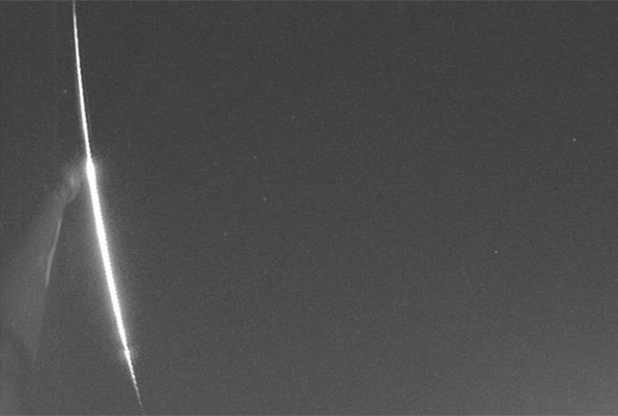The 'bolide' meteor was a random ball of metals that exploded as it entered the atmosphere - and experts say it may have landed before it was able to burn up.
The flash was caught for more than seven seconds as it streaked over our skies, thanks to a meteor observation camera at Exeter Observatory.
The observatory's John Maclean, a Fellow of the Royal Astronomical Society, said the flash was so bright it was easily visible to the naked eye.
He said: "Someone saw it and called me, so this was obviously a very bright one. The person who saw it was out walking their dog and described a bright green flash. This was a bolide, or fireball - not usual."
Mr Maclean, an astronomer and lecturer who works with NASA and has a 25-year military background, said the Exeter Observatory is part of a network that captures more than 20,000 meteors on camera every year - but very few this impressive.
He said the Exeter camera is part of the 48-camera UK Meteor Monitoring Network.
Mr Maclean said: "You can see meteors all the time if you're looking in the right direction, but we only see a bolide like this once every three months or so."
Comment: During the past couple of months some meteor fireball sightings from around the UK and Ireland include:
- Meteor fireball seen in the skies above Huddersfield, UK
- Meteor fireball seen over Donegal, Ireland
- SOTT Exclusive: Four Fireballs Streak Across Irish Sky
- Meteor fireball photographed hurtling towards ground in Wraysbury, UK
- Blazing fireball sighting over Scotland was probably meteor
- Meteor fireball observed over Ireland and northern UK
He said analysis would now be carried out to determine where the meteor came from, and where it ended up, by triangulating the images they have captured.
Meteors would usually burn up before reaching the earth's surface.
Mr Maclean said: "Meteors are usually no bigger than a grain of sand, but this would have been a little bigger and it's possible it landed somewhere. We'll analyse the data now and we can work out where it came from, and where it may have landed."
The meteor may have come from the asteroid belt, according to Mr Maclean, and could have been caused by a collision of asteroids. It became visible as the Earth passed through the debris.
He said: "The bright green flash would have been caused by the tremendous friction that causes the meteor to produce light and to ultimately disintegrate before reaching the Earth's surface.
"The colour is a result of atoms in the meteoroid emitting light because they are heated up by entering the atmosphere, and so they burn and release different wavelengths of light, or different colors, in the same way that putting different compounds into fireworks makes them explode in different colors."
The video image captures the meteors in mono, for a sharper definition.
There will be a chance to see a large number of meteors over Exeter later in the year during the Perseid meteor shower, which starts in March and peaks in June.




Reader Comments
to our Newsletter